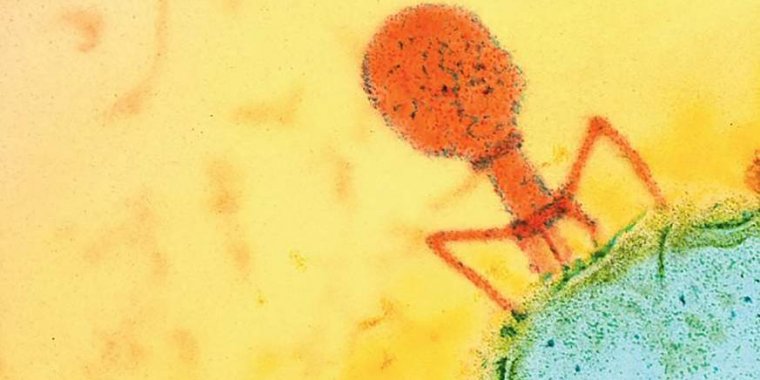| News / Science News |
Bacteriophage therapy may ease severity of alcoholic hepatitis
A specific strain of a common bacteria found in most people with alcoholic hepatitis correlates with greater liver disease severity and mortality.

In this false-color micrograph, a bacteriophage (orange) attaches to the membrane of a bacterial cell (blue). Photo: UC San Diego
Alcoholic hepatitis is a serious form of alcohol-associated liver disease, and people with it have high levels of the bacterium Enterococcus faecalis (E. faecalis) in their gut.
The study also found that a novel therapeutic approach that specifically targets the E. faecalis strain lessened alcohol-associated liver disease in mice.
A multitude of bacteria populate the human digestive tract, and this gut microbiota plays important roles in maintaining health. With chronic alcohol misuse, the levels and types of bacteria in the gut microbiota change which contributes along with other factors to alcohol-associated liver diseases such as alcoholic hepatitis.
In analyses of gut microbes from alcohol use disorder (AUD) patients with alcoholic hepatitis, a team of scientists led by Bernd Schnabl, M.D., of the University of California, San Diego, found that fecal samples from patients with alcoholic hepatitis had about 2,700-fold more E. faecalis than samples from non-AUD controls.
Further studies of E. faecalis, showed that cytolysin, a toxin secreted by specific E. faecalis strains, killed liver cells and caused liver damage in a mouse model of alcohol-associated liver disease.
“We detected cytolysin-positive E. faecalis (cytolytic E. faecalis) in fecal samples from 30% of patients with alcoholic hepatitis, and in none of the fecal samples from non-AUD controls,” said Dr. Schnabl. “Importantly, 89% of cytolysin-positive patients with alcoholic hepatitis died within 180 days after admission compared to only about 4% of cytolysin-negative patients.”
In another series of experiments, the researchers studied mice that had been transplanted with feces from the intestines of people with alcoholic hepatitis and that contained cytolytic E. faecalis.
They confirmed that transplantation of the bacteria caused severe liver disease in mice. Dr. Schnabl and his colleagues then investigated the therapeutic potential of bacteria-killing viruses known as bacteriophages that specifically target cytolytic E. faecalis.
Using a mouse model of alcohol-associated liver disease, mice were transplanted with stool from cytolysin-positive alcoholic hepatitis patients and treated with a cocktail of bacteriophages targeting the cytolytic E. faecalis strains.
The researchers found that mice treated with bacteriophages that target cytolytic E. faecalis had less liver injury and inflammation compared to controls. Administration of E. faecalis-targeting bacteriophage also significantly reduced levels of cytolysin in the liver.
“Taken together, our findings link cytolytic E. faecalis with worse clinical outcomes and mortality in humans with alcoholic hepatitis, and that bacteriophages can specifically target cytolytic E. faecalis in a mouse model of alcohol-induced liver disease,” said Dr. Schnabl. (National Institutes of Health)
YOU MAY ALSO LIKE





